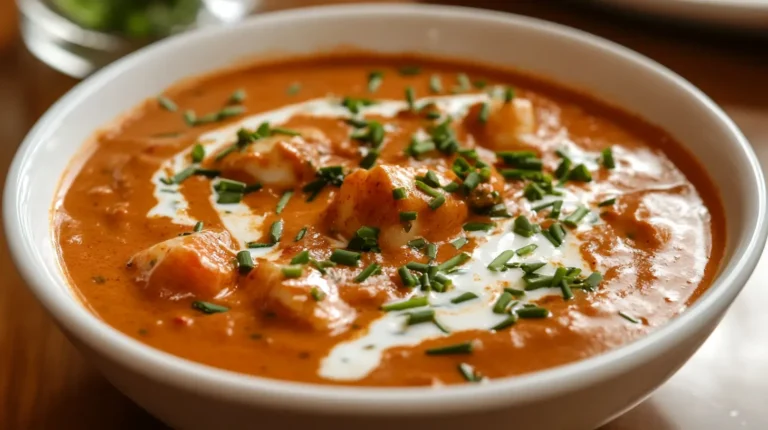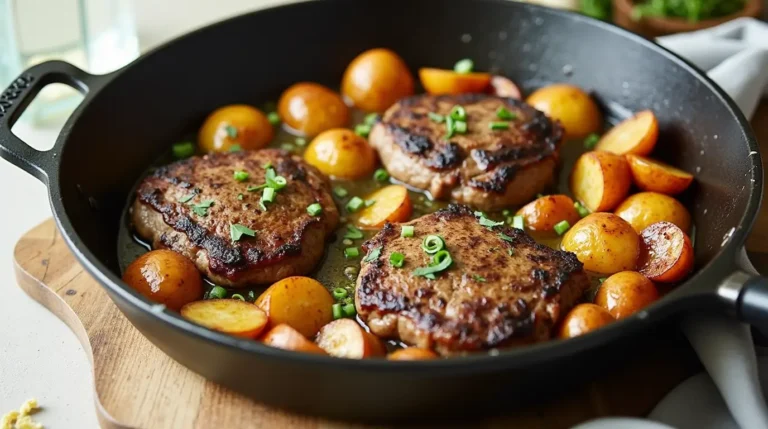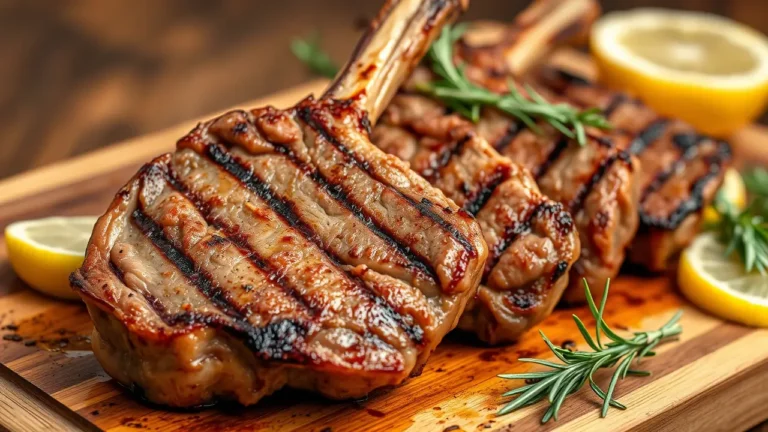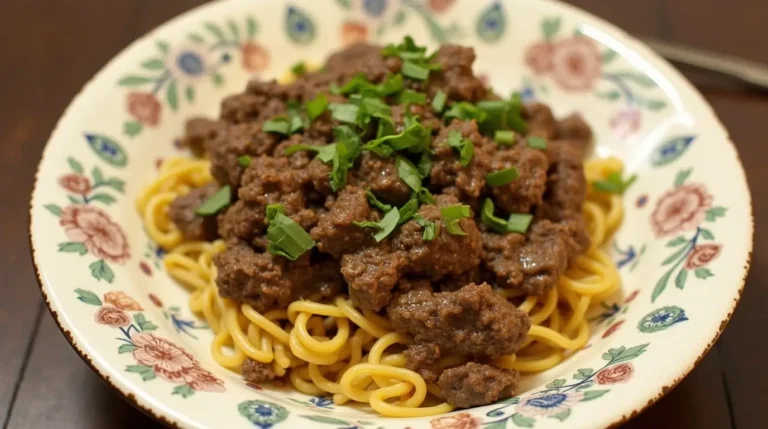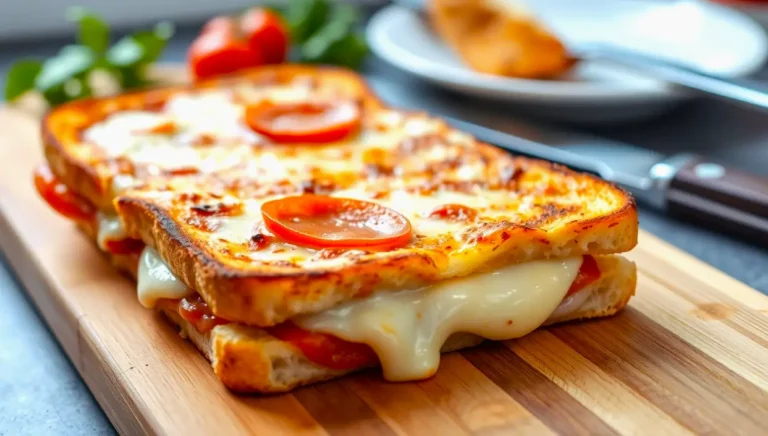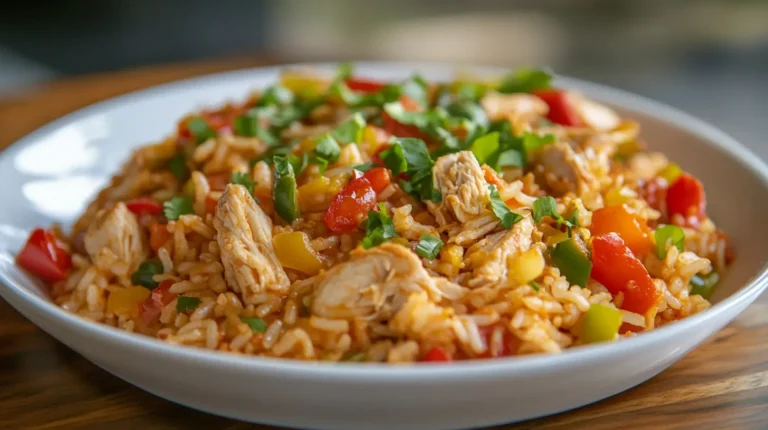Seafood Paella: 7 Tips To Make It Better
Few dishes capture the spirit of Spain quite like seafood paella. This colorful, aromatic rice dish is more than just food—it’s a communal experience, a centerpiece for gatherings, and a symbol of Spanish coastal cuisine. Originally from Valencia, paella has become one of Spain’s most beloved exports, with seafood paella standing out as the star variation. With its mix of fresh shellfish, saffron-scented rice, and the sought-after crispy socarrat (the caramelized rice crust at the bottom of the pan), it’s no wonder this dish is celebrated worldwide.
If you’ve ever wanted to bring the flavors of Spain into your kitchen, this guide will walk you through everything—from its history and key ingredients to step-by-step cooking instructions.
Table of Contents
The Origins of Paella
The word paella actually refers to the wide, shallow pan used to cook the dish. The roots of paella trace back to Valencia, where workers in the fields would prepare rice cooked with seasonal vegetables and whatever proteins were available—such as rabbit, chicken, or snails. Along the coastal regions, however, abundant seafood naturally became the main star, giving birth to the seafood paella we know today.
While purists argue that only Valencian paella is “authentic,” seafood paella has grown into its own tradition, especially in seaside towns. Today, it’s one of the most popular variations served in homes and restaurants alike.
Key Ingredients for Seafood Paella
To make a paella that serves 4 people, you’ll need:
Rice
- 2 cups (400 g) Bomba rice (or Calasparra; if unavailable, Arborio is a substitute)
Seafood
- 8 large shrimp or prawns, shell-on
- 12 mussels, scrubbed and debearded
- 12 clams, scrubbed
- 150 g (5 oz) squid rings or pieces
- Optional: 1 small lobster or 6 scallops for extra richness
Vegetables & Aromatics
- 1 medium onion, finely chopped
- 3 cloves garlic, minced
- 2 medium tomatoes, grated or finely diced
- 1 red bell pepper, sliced into strips
- ½ cup (75 g) green peas (fresh or frozen)
Broth & Seasonings
- 4 cups (1 liter) seafood stock (homemade if possible)
- 1 tsp saffron threads, steeped in 2 tbsp warm water
- 2 tsp smoked paprika
- Salt to taste
- 4 tbsp extra virgin olive oil
Garnish
- Lemon wedges
- Fresh parsley, chopped
Traditional vs. Modern Seafood Paella
Traditional Valencian paella typically features rabbit, chicken, and beans, but as the dish evolved along the coast, seafood became its natural addition. Today, many restaurants offer mixed paella—a combination of chicken and seafood—but purists argue that true seafood paella should highlight fish and shellfish only.
Modern variations also include Paella Negra, made with squid ink, and vegetarian versions with plant-based seafood substitutes. But no matter the twist, the heart of paella remains the same: saffron-infused rice cooked in a wide pan until tender and flavorful.
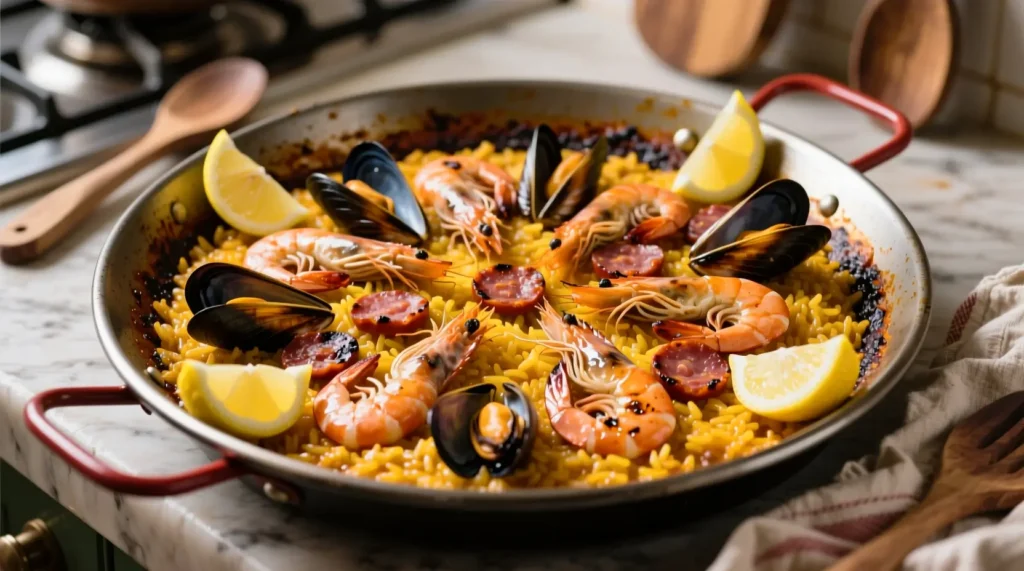
Step-by-Step Cooking Guide
1. Prepare the Ingredients
- Rinse the clams and mussels under cold water, discarding any that are cracked or remain open.
- Peel and devein the shrimp, leaving the tails on for presentation.
- Heat the seafood stock in a saucepan and keep it warm. Add the saffron threads steeped in water to the stock.
2. Make the Sofrito (Flavor Base)
- Heat olive oil in a paellera (paella pan) or large, wide skillet.
- Sauté the onion and garlic until translucent.
- Stir in the grated tomato and cook until it forms a thick paste.
- Add smoked paprika for depth of flavor.
3. Add the Rice
- Stir the rice into the sofrito, coating each grain in oil and seasoning.
- Cook for 1–2 minutes to lightly toast the rice.
4. Add Broth and Simmer
- Pour in the warm seafood stock, stirring once to distribute evenly.
- Spread the rice in a thin, even layer—do not stir again after this point.
- Arrange the bell pepper strips across the rice for color.
5. Add the Seafood
- After about 10 minutes, nestle the squid, clams, and mussels into the rice.
- Place the shrimp on top after 15 minutes of cooking.
- Scatter peas over the surface for color.
6. Achieve the Socarrat
- Allow the rice to cook undisturbed until the liquid is absorbed and you hear a gentle crackling.
- To intensify the socarrat, increase the heat for the final 1–2 minutes, but avoid burning.
7. Rest and Serve
- Remove from heat, cover with a clean kitchen towel, and let rest for 5 minutes.
- Garnish with lemon wedges and parsley.
- Serve straight from the pan for the authentic Spanish experience.
Equipment You’ll Need
A paella pan (paellera) is the most important tool—it’s wide and shallow, allowing the rice to cook evenly. If you don’t own one, a large, flat skillet will work in a pinch. For heat, an outdoor gas burner or grill provides the most authentic results, but a stovetop with even heat distribution is fine. A wooden spoon or spatula is best for stirring the sofrito.
Tips for the Perfect Seafood Paella
- Choose the right rice: Bomba rice absorbs liquid without becoming mushy.
- Don’t stir after adding stock: Stirring prevents the socarrat from forming.
- Layer your seafood: Add shellfish in stages so nothing overcooks.
- Control the broth ratio: About 2 cups of liquid for every cup of rice.
- Rest before serving: This lets the flavors settle and the rice finish steaming.
Serving Suggestions & Pairings
Seafood paella is traditionally served family-style, right from the pan. Garnish with lemon wedges to cut through the richness, and sprinkle fresh parsley for brightness. Pair it with a crisp Spanish white wine like Albariño, sparkling cava, or even a chilled pitcher of sangria. On the side, consider a light green salad or pan con tomate (Spanish tomato bread).
Variations of Seafood Paella
- Paella Negra: Uses squid ink for a striking black color and rich flavor.
- Mixed Paella: Combines chicken and seafood for a heartier version.
- Vegetarian “Seafood” Paella: Uses artichokes, mushrooms, or plant-based seafood alternatives.
Nutritional Information (per serving, approx.)
- Calories: 480
- Protein: 32 g
- Carbohydrates: 52 g
- Fat: 15 g
- Rich in omega-3 fatty acids, iron, and antioxidants from saffron and vegetables.
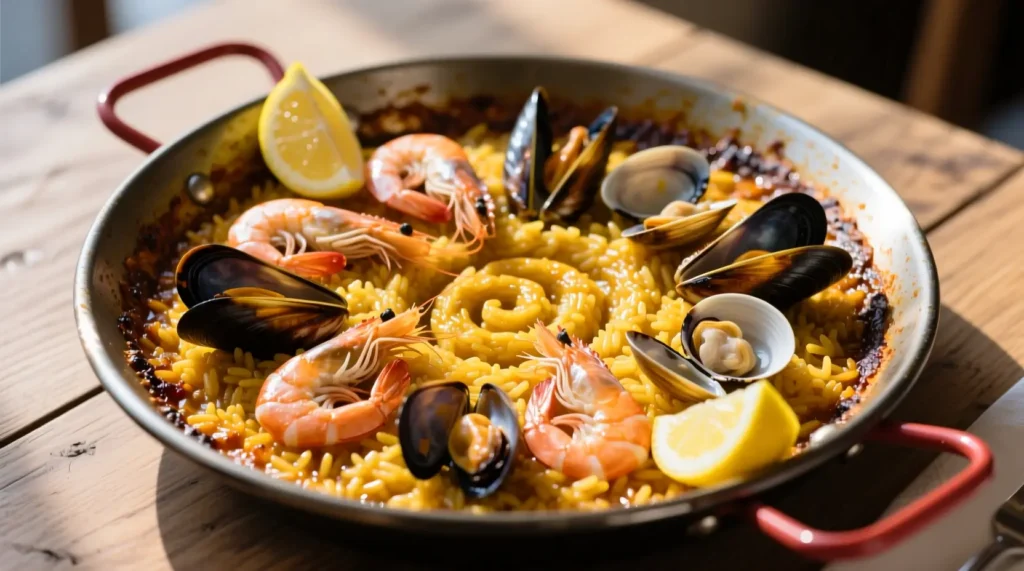
FAQs
Q: What is the secret to the best seafood paella?
A flavorful homemade stock, good-quality saffron, and achieving the socarrat are the secrets.
Q: Do you stir paella while cooking?
No. Once the stock is added, avoid stirring to allow the crust to form.
Q: Can you make paella without saffron?
Yes, but saffron provides the authentic color and flavor. Turmeric can be a substitute, though the flavor is different.
Q: What rice is best for paella?
Bomba rice is the gold standard. Calasparra or Arborio rice can also work.
Q: Can paella be made ahead of time?
It’s best enjoyed fresh, but you can partially cook it and finish just before serving.
Q: What’s the difference between risotto and paella?
Risotto is stirred constantly to create a creamy texture, while paella is cooked undisturbed, resulting in a drier, separate-grain texture.
Conclusion
Seafood paella is more than just a dish—it’s an experience steeped in tradition and flavor. With its vibrant colors, briny seafood, golden saffron rice, and the prized socarrat, it’s a recipe that brings people together around the table. Whether you’re recreating it for a festive dinner or simply to transport yourself to the Spanish coast, seafood paella is a dish worth mastering.
Don’t forget to explore dishes like birria tacos


